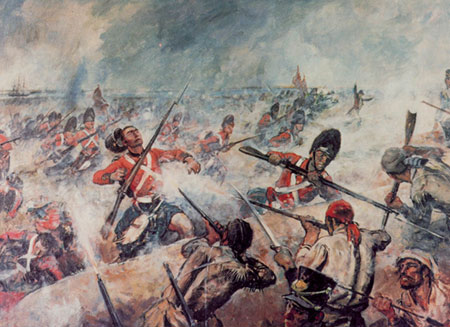Warfiless:
War of 1812 (1812-1815)

The Battle of New
Orleans in 1815
War of 1812
(1812-1815)--Sometimes called
the Second American War of Independence, this conflict
pitted the young United States against her old colonial
ruler, Britain. The war began over leftover issues from
the first American-British War, and from Britain's
ongoing wars against Napoleon and France.
This second
Anglo-American war began in 1812 and ended in 1815. Over
1,600 British and 2,260 American soldiers, marines, and
sailors perished in this war on both land and on the
ocean. While at war with the United States, Britain was
also fighting against France and her allies in
Europe.
Due to their
war with France, the British sought to restrict American
trade with France, and imposed a set of restrictions
which the U.S. considered illegal under international
law. The U.S. declared war on Britain on July 18, 1812
after years of enduring British restrictions and attacks
on American shipping, the forcible impressment of
thousands of American sailors into service with the
British navy, increasing anger at British restraints on
American trade with France and other European nations,
and frustration at continuing British military support
for Native Americans fighting against the expanding
United States.
When war was
declared by the United States in the summer of 1812, the
American military was woefully unprepared for conflict
with the world's most powerful empire. Even though the
British were engaged in a life and death struggle with
Napoleon's France, troops were sent to reinforce British
Canada and to battle the Americans.
The war that
developed was a repeat of the American desire to invade
and absorb Canada. Just as in the American Revolutionary
War, British and Canadian forces beat back an American
invasion. Modern Canadians trace the first true inkling
of their nationhood to this war and the Canadian
contribution to their own defense.
The war
featured several battles, as the Americans invaded
Canada, the British landed troops in the U.S. and burned
Washington, D.C. The final battle of the war came in New
Orleans in early 1815, with a clear American victory over
an invading British army. Ironically, the Treaty of Ghent
was signed on December 24, 1814, in the city of Ghent,
Belgium. Due to the slow means of communication at that
time (sailing ships travelling from Europe to America
would take about two weeks to arrive), several more
battles were fought after the signing of the treaty. On
January 8, 1815, General Andrew Jackson defeated a large
British force at New Orleans. On February 12, 1815, the
British won a battle and captured the American
Fort Bowyer, in Mobile, Alabama.
Recieving word the next day of the signing of the Treaty,
British forces abandoned the fort and left American
territory.
On February, 18, 1815, President James
Madison officially notified Congress of the Treaty of
Ghent, thereby ending the war.
The
War of 1812 Began:
July 18, 1812
The
War of 1812 Ended:
February 18, 1815
The
War of 1812 Was Fought
Between:
United States vs. Great Britain
Location
of The War of 1812 : The
fighting centered on the U.S. East Coast, New Orleans,
Canada, and in both the Atlantic and Pacific
Oceans
The
War of 1812 Resulted In:
Effectively a stalemate, though the U.S. considered it a
victory over a much more powerful opponent
The
Length of The War of 1812:
Two
years and eight months
The
War of 1812 Casualties:
American
Military Casualties:
2,260 Deaths
Army: 1,950
Navy: 265
Marines: 45
4,505 Wounded
Army: 4,000
Navy: 439
Marines: 66
*An estimated 15,000 total deaths
occurred due to the war on the American side. As is
typical of warfare in this era, more deaths occurred
from disease and other causes than through actual
battle wounds and causes.
British
Military Casualties:
1,160 Deaths
3,679 Wounded
British Military Deaths and Wounded in
the War of 1812: (Non-Battle Casualties)
3,321 Deaths by
Disease
Sources: